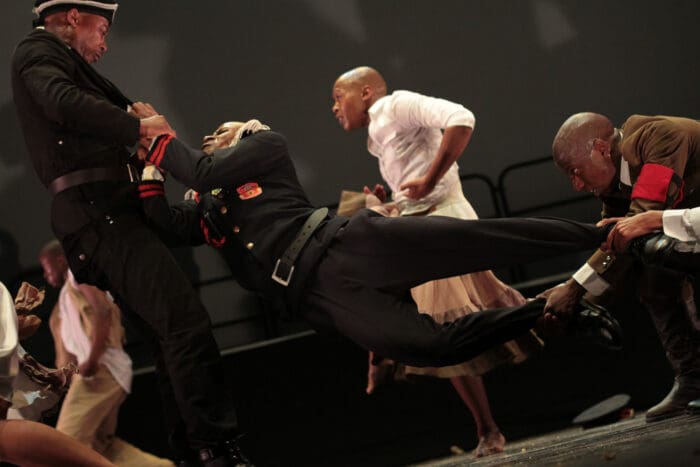
Umnikelo (Offering)
The opening night of Luyanda Sidiya’s double-bill performances of Umnikelo and Dominion was dedicated to putting an end to xenophobic violence.
Umnikelo—meaning offering—would be an invitation hard to refuse. Opening onto a stage bathed in a beautiful golden light, the Vuyani dance company is poised while live song, vocalizations, and drumming draw the audience in. As the dancers begin moving through the space it is hard not to be in awe of their athletic and technical skill. Well matched to Sidiya’s eclectic and strong technical background, the choreography skillfully blends contemporary technique with a fusion of different South African dance styles, and the dancers transition through the different movement techniques seamlessly. While form takes precedence over narrative, there is the sense that the dance has a heartbeat, that it is from the earth and is rising up. At intermission the audience jumps to their feet in what feels like a truly celebratory standing ovation.
Dominion
Though the stage was bathed in a similar golden glow, Dominion’s content was much more stark in comparison to Umnikelo. Sidiya’s well crafted images reveal a severe rift between state military bigwigs and the common peasantry—this image evokes not one particular time and place in history, but could stand in for so many. An early notable scene presents a group of men costumed in brass and medals glad-handing on a riser at the back of the stage while opening and sharing a congratulatory bottle of champagne amongst themselves, Charlie Chaplin’s famous final speech from The Great Dictator playing as accompaniment. This scene of state opulence quickly dissolves as the peasants begin to gather downstage. First, one of the decorated men throws a piece of bread down to the dancers, they descend upon it and scuffle as the winner eventually shoves the bread into her mouth and all turn look back up to the men on the riser.
More bread is thrown, the peasants squirmish for their fair share, the stage is littered with bread crumbs for the remainder of the performance. The desperation of the people, their hunger, their socio-economic circumstances, the gross inequalities, lead to an inevitable revolutionary fight. Here Sidiya gives a direct nod to South Africa’s revolutionary past by incorporating a stylized movement that invokes the toyi-toyi—a march-step used during protests and intimately tied to the anti-apartheid struggle. Tension mounts between the state and the people, articulated through intense percussive movement, and lifts and throws that are bound and restricted rather than landing with free follow-through.
During the final scenes a speech praising Zulu Kings past and present plays over the action, book-ending the work after Chaplin’s earlier call for democratic equality for all. Dominion also receives a standing ovation, though it feels more constrained than the earlier one received by Umnikelo. Perhaps the lasting image, a man in military dress literally standing on the backs of the peasantry before the stage fades to black, has left the audience feeling more contemplative than celebratory.
